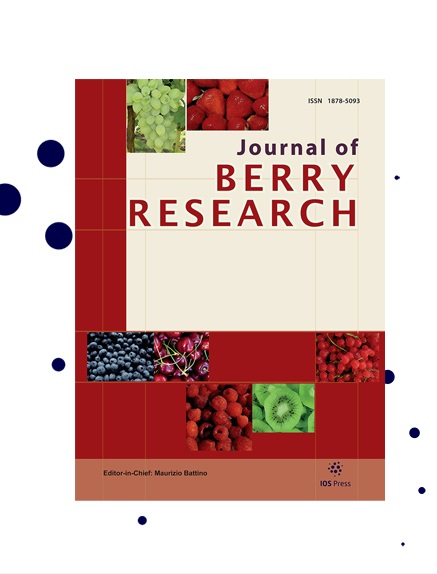Modulatory effect of Andean blackberry polyphenols on genes related to antioxidant and inflammatory responses, the NLRP3 inflammasome, and autophagy
IF 1.4
4区 农林科学
Q3 PLANT SCIENCES
引用次数: 0
Abstract
BACKGROUND: The Andean blackberry (Rubus glaucus Benth) is one of Ecuador’s most iconic Andean berries for which a high anthocyanin content has been described. OBJECTIVE: The aim of the present study was to determine the chemical composition and anti-inflammatory potential of the Andean blackberryfrom Ecuador, with an emphasis on its effects on NLRP3 inflammasome activation and autophagy processes. RESULTS: Andean blackberry extracts were rich in hydroxycinnamates (coumaric acid and derivates), in addition to quercetin and kaempferol as principal flavonols. Cyanidin and its glycosides were identified as the main anthocyanins present. Andean blackberry extracts efficiently reduced oxidative stress markers in the lipopolysaccharide-stimulated RAW 264.7 cells. The extracts also caused a moderate decrease in the expression of the pro-inflammatory and antioxidant genes NFκB1, TNF, IL-1β, IL-6, and NOS2 expression, while they significantly increased the mRNA levels of both SOD1 and NFE2L2 genes. Andean blackberry extracts significantly decreased the activation of the NLRP3 inflammasome complex, as well as p62 levels, and the LC3I/LC3II ratio increased, suggesting a direct action of Andean blackberry compounds on the inflammatory response and restoration of the autophagy process. CONCLUSIONS:These results suggest that Andean blackberries potentially have an anti-inflammatory effect through their ability to regulate genes related to the inflammatory and antioxidant response, as well as modulate the activation of the NLRP3 inflammasome complex and autophagy processes.安第斯黑莓多酚对抗氧化和炎症反应、NLRP3 炎症体和自噬相关基因的调节作用
背景:安第斯黑莓(Rubus glaucus Benth)是厄瓜多尔最具代表性的安第斯浆果之一,花青素含量很高。目的:本研究旨在确定厄瓜多尔安第斯黑莓的化学成分和抗炎潜力,重点研究其对 NLRP3 炎性体激活和自噬过程的影响。结果:安第斯黑莓提取物富含羟基肉桂酸盐(香豆酸及其衍生物),此外还有槲皮素和山奈酚作为主要的黄酮醇。经鉴定,花青素及其苷类是主要的花青素。安第斯黑莓提取物能有效减少脂多糖刺激的 RAW 264.7 细胞中的氧化应激标记物。安第斯黑莓提取物还适度降低了促炎和抗氧化基因 NFκB1、TNF、IL-1β、IL-6 和 NOS2 的表达,同时显著提高了 SOD1 和 NFE2L2 基因的 mRNA 水平。安第斯黑莓提取物能明显降低 NLRP3 炎性体复合物的激活以及 p62 的水平,LC3I/LC3II 的比率也有所提高,这表明安第斯黑莓化合物能直接作用于炎症反应并恢复自噬过程。结论:这些结果表明,安第斯黑莓能够调节与炎症反应和抗氧化反应相关的基因,并调节NLRP3炎性体复合体的激活和自噬过程,因而具有潜在的抗炎作用。
本文章由计算机程序翻译,如有差异,请以英文原文为准。
求助全文
约1分钟内获得全文
求助全文
来源期刊

Journal of Berry Research
Biochemistry, Genetics and Molecular Biology-Biochemistry
CiteScore
3.50
自引率
11.80%
发文量
21
期刊介绍:
The main objective of the Journal of Berry Research is to improve the knowledge about quality and production of berries to benefit health of the consumers and maintain profitable production using sustainable systems. The objective will be achieved by focusing on four main areas of research and development:
From genetics to variety evaluation
Nursery production systems and plant quality control
Plant physiology, biochemistry and molecular biology, as well as cultural management
Health for the consumer: components and factors affecting berries'' nutritional value
Specifically, the journal will cover berries (strawberry, raspberry, blackberry, blueberry, cranberry currants, etc.), as well as grapes and small soft fruit in general (e.g., kiwi fruit). It will publish research results covering all areas of plant breeding, including plant genetics, genomics, functional genomics, proteomics and metabolomics, plant physiology, plant pathology and plant development, as well as results dealing with the chemistry and biochemistry of bioactive compounds contained in such fruits and their possible role in human health. Contributions detailing possible pharmacological, medical or therapeutic use or dietary significance will be welcomed in addition to studies regarding biosafety issues of genetically modified plants.
 求助内容:
求助内容: 应助结果提醒方式:
应助结果提醒方式:


